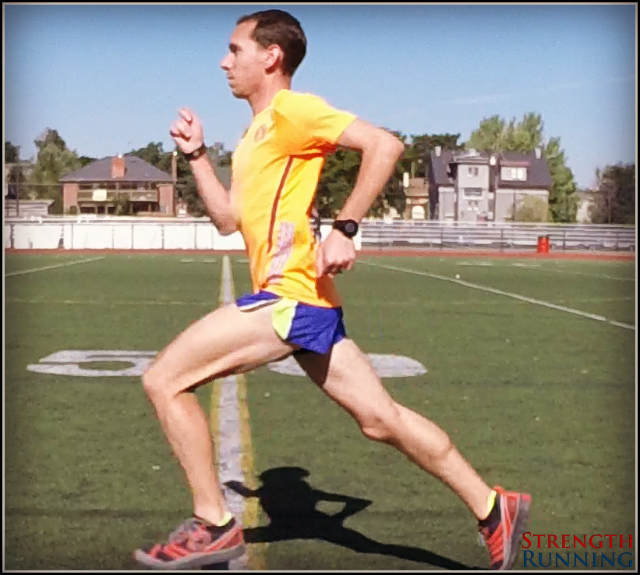Whenever I’m asked about running form, I nearly have a panic attack. What should I say when I’m so conflicted?!

Working on my split-leg game since 1998
You see, I don’t like to steer runners in the wrong direction. My goal is to point out the advice that doesn’t work and focus on fundamentals that never change.
But I also want runners to run faster. And that means reconciling two conflicting truths:
- Having “proper” form is incredibly important – we should try to improve our form
- There is NO ideal way to run and actively changing your form can result in injuries or losing efficiency (or both)
How do we improve our running form… without trying to change our form?
It may seem paradoxical – but it’s possible!
And in fact, optimizing your stride isn’t nearly as difficult as you might think. You don’t need to proactively “fix” any biomechanical errors you might have.
The solution is three-fold:
- Develop the strength necessary for an optimized stride
- Counteract the harmful effects of our modern, sedentary lives
- Improve mobility and movement patterns to make economical running far easier
Thankfully, Strength Running readers are already ahead of the pack (as usual). If you’ve been part of our community for long enough, you know that I emphasize key aspects of training that will improve your form automatically.
These things are:
- A focus on core stability and hip and glute strength (check out my favorite strength exercises)
- Dynamic exercises done before you go running to improve range of motion
- Regular strides or hill sprints to reinforce economical running form
But there’s always more that we can do. And if you’re a runner that’s passionate about improvement, you won’t want to miss the latest episode of the Strength Running podcast.
“Run the Way You Were Born to Run”

Jonathan Beverly was the editor-in-chief of Running Times for 15 years. He’s run nearly 30 marathons and hundreds of road and trail races around the world.
He’s also coached with the New York Road Runners Club, taught several college running classes, and has coached junior and high school track and cross country since 2003.
Jonathan’s new book quickly became one of my favorites. Your Best Stride: How to Optimize Your Natural Running Form to Run Easier, Farther, and Faster – with Fewer Injuries is a holistic look at how to run with better form.
He does not promote a certain brand of form (like Chi or POSE).
He won’t make you run on your forefoot (that’s a big no-no).
And he isn’t even gung-ho about “cues” that make you run slightly differently.
Instead, the goal is to bring you back to when you were 10 years old. Remember back then? If not, just know that you ran with a lot better form back then.
Jonathan is on the podcast today to discuss how to reclaim your youthful, smooth, powerful stride.
Subscribe on iTunes or on the Stitcher platform.
Links & Resources:
- Your Best Stride by Jonathan Beverly
- Jonathan’s website
- Jason’s (cheap) standing desk
- Anatomy for Runners by Jay Dicharry
- Born to Run by Christopher McDougall
- Jonathan Beverly on Twitter
- The Running Form Course
Are you a fan of the podcast? Share this episode or leave an honest review on iTunes – it’s the best way of showing your support!
This episode is sponsored by Health IQ, an insurance company that helps health conscious people get special life insurance rates. Head on over to healthiq.com/strengthrunning to see how your running can help you save on insurance.
They’ve pulled the latest data on runners’ health risks to convince insurance companies to offer cheaper rates. Just consider:
- Runners have a 41% lower risk of heart disease
- Runners also have up to a 35% lower risk of premature death
And they’ve been successful: over the last three years, they’ve helped health-conscious athletes secure billions of dollars in coverage.
Want to see if you qualify for cheaper life insurance? Check out this tool to get your free quote.